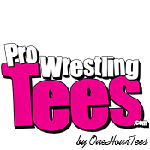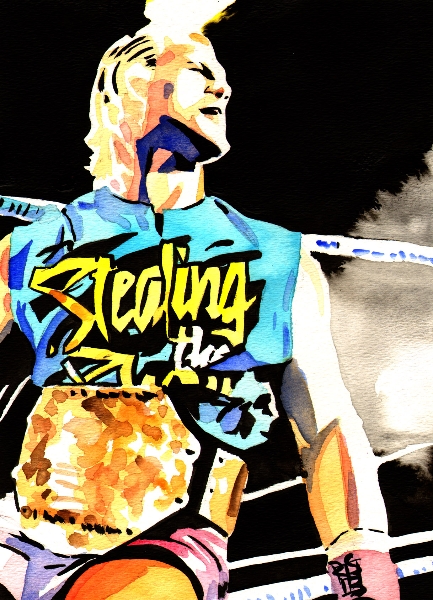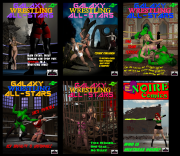Chapter 11: Making Wrestling Television By Matt Murphy
Posted by flairwhoooooo on November 30, 2009
As professional wrestling evolved into sports-entertainment, the televised product evolved as well. On the surface, small-scale wrestling television is rarely profitable. Its purpose is to to drive fans to live events by developing wrestlers compete in matches viewers will pay to see live.
Most TV stations want the promotion to pay for the time slot, with the promoter responsible for selling ads and retaining all or part of the proceeds. I was fortunate to help work out a deal where the station filmed the footage, aired our program, and sold advertisements for the program on their own. It worked well for us because we had a one-hour commercial for our events every week; it worked well for the television station because they sold out on the advertising time allotted for the Saturday-night program quickly enough to convince the owner to replay our program on Sunday morning, creating 28 new advertising spaces.
It’s been said many times that fans are talked into arenas: I agree. Sure, you might sell a few tickets to fans who want to see a technical wrestling clinic between The Silent Assassin and The Mute, but it’s the promos and storylines that put the most asses in seats.
Wrestlers need to be able to deliver a solid promo. You should be practicing at home in front of a mirror or camcorder regularly. Promos were once ad-libbed: the only instructions were bullet points, at most. Now, nearly every TV promo is scripted. I hate it. I preferred to give wrestlers bullet points and let them have a little room for creativity and spontaneity. WWE does not; thus, there will likely never be another spontaneous cash-cow like “Austin 3:16″. As long as the wrestlers get the assigned points across, acted like they believed and cared about what they said, and hit their marks on time, I was content. But I produced a very small program.
You need a balance of promo styles: the insane, the I’m-just-glad-to-be-here rookie babyface, the strategist, the yeller, the quiet, the funny. If every wrestler screams, it loses its effect.
When conducting interviews, I liked to do a quick summary of whatever controversy surrounded the wrestler at the time, then I let him comment on it. I’d ask him about his upcoming match, maybe about his strategy, then pass it to him. I then wrapped up the interview and sent the program to a commercial or the next match.
A wrestler should never take the microphone from the announcer. Imagine how little the fans would have respected Gordon Solie had he been pushed around by wrestlers. The announcer should lend an aura of class to the program, and bullying him has a negative effect on his credibility. He should be presented as the voice of the fans, not as a performer.
As a rule of thumb, I didn’t talk about things in front of a live audience that they wouldn’t get to see. If I needed a promo for something that the live audience would see that night, then it would be done as an in-ring interview. If not, then I would do a backstage promo. We traveled around a lot, and most of our towns didn’t have access to our program on weekly TV. That raised the question, Which is more important, the live crowd or the TV viewers? I believe the live crowd is most important, because people watching on TV who can feel the crowd’s excitement are more likely to buy a ticket to feel that same live thrill. There are times when you must sacrifice the concerns of the live crowd for the benefit of the TV product, and vice-versa, when those two audiences are not one in the same.
When you host a live event in a town which has access to your televised product, try not to run the live event on the same night your televised program airs. I suggested airing a replay of a previous program when that occurred. Why punish the ticket-buying fan by making him miss a new week of the TV program in order to see the event live? If you air a replay, then you’ve given the fans nothing to miss on TV.
I pushed for a long time to create and sell a WLW newsletter at events. I always worried that a live crowd outside our TV coverage area couldn’t follow our storylines, so I thought that selling a newsletter, where I could get over the angles and give the fans a better idea of what’s happening and who the wrestlers are, would improve the live element of our events.
Before I get too deep into this chapter, let me emphasize this: I produced a small television show for an independent promotion that was broadcast on one cable-television station and one public-access station. What follows is knowledge gained from trial-and-error and should not be taken as expertise. I’m sure there is a better, cheaper way of producing a wrestling television show, but this is how I did it given the resources I had available.
You need to have your program timed out. I used a segment-by-segment spreadsheet, but I always wanted to use a bullet-pointed television script. The following is an example of what my spreadsheet looked like:
Sample World League Wrestling Spreadsheet

Let’s break down this one-hour program. Our primary TV station allowed us forty-six minutes for this program, which aired at 10:30 on Saturday nights and replayed at 11:00 on Sunday mornings. The fourteen additional minutes were broken into seven two-minute commercial breaks (two four-minute and two three-minute breaks would have been ideal), with the final break between the end of our program and the start of the program that followed it.
This particular program is not timed like I preferred due to the frequent commercial breaks during the first half. Notice how five of the seven commercial breaks had aired by the 33:00 mark? This was because I wanted the fans to understand the importance of the main event, a match so big that we wouldn’t dare interrupt it with a commercial break.
I used a VTR (video-tape recorded) package summarizing the story between the main-event wrestlers to open the show. I also added a pre-taped (PT) backstage (BS) promo by Branden Tatum and a 30-second PT-BS video showing Dinn T. Moore getting psyched up for the match. I used PT instead of VTR to remind myself that we didn’t already have that footage in the bag, that it needed to be taped before the event started. I wanted viewers to really get excited for the main event, a match that would settle a brutal feud between former partners, so this program ended with closure instead of a cliff-hanger. It was the end of a chapter in both mens’ careers. I also didn’t want to take attention away from the build of this match, so I didn’t have anybody else cut a promo during this program. I previewed next week in the wrap-up, but I really wanted this match to make fans think that this was something they were very lucky to get on free television.
Though I didn’t like to do it, I put a commercial break in the Wade Chism vs. Marc Godeker match. This gave me a safety net, in case the show ran long. Since Marc was going over, I cut to break early-on during his heat. I came back two minutes before Wade’s comeback, so viewers would see Marc on top briefly, but it appeared that Wade controlled most of the match until Marc snuck in a quick roll-up for the pin.
I liked to do intro and wrap-up segments in our program, where I welcomed and thanked the viewers, commented on anything significant during the hour, and previewed this and next week’s programs.
Match times include introductions and the outshot (the last thing in a segment the fans see before we move to a commercial break or the next segment), so an eight-minute match, in reality, is only about six minutes of in-ring action.
Prior to the introduction, I faded in to the ring announcer before he began to speak. I needed him to stand still and look at the camera for two seconds so I wouldn’t come in to a shot of him letting out a deep breath or sucking candy out of his teeth.
We did a two-camera shoot, with one hard camera and one on the floor. We tried to position the seats so that most of the crowd was in the hard camera shot, giving the impression that we had a full house whether we really did or not. The floor cameraman filmed mostly at an angle, working from one of the corners closest to the hard camera toward the crowd.
When entrances were filmed, I wanted the floor camera getting most of it. When the hard camera panned toward the entrance, it often showcased empty seating, which looked worse on-camera than in-person. The floor cameraman stood at the ring post nearest the entrance with the top of the wrestler’s head at the upper one-third line of the screen (so I wouldn’t cover his face when I added the graphics later).
I liked to have crowd shots, but at appropriate times. I actually took over editing because our first program showed crowd shots during hope spots — not shots of fans clapping while the babyface was summoning support, but shots taken while the babyface was fighting back — so viewers missed that part of the story. It takes people who know wrestling — or at least watch wrestling a lot on TV — to edit it.
Here are a few random things I’ve learned since we began doing TV:
A wrestler not involved in the match should not be seen on camera. This means he should not be in view of a camera while watching a match, returning from the concession stand, or playing with his kids. At one of our events, a wrestler sat in the bleachers in the dead-center of the hard camera shot, his arm around his girlfriend, during the entire program. During that same program, another wrestler was playing with his kids on camera. Hey! That bad guy who I’m supposed to despise sure looks like a good father, doesn’t he?
If the entrance is accessible to fans, security needs to make sure that kids aren’t running in the wrestler’s path to the ring. First, it’s a safety liability. Second, it makes for a bad shot when a wrestler almost trips over a kid running in front of him.
Make sure the hard camera is set up in a place where fans aren’t sitting. Tape off the hard-camera side of the bleachers if that is where you’re set up; if not, your camera will shake every time somebody takes a step.
Here comes a bunch of technical crap, so feel free to skim until the last paragraph of the chapter if you aren’t interested in this facet of wrestling TV. I’ve included prices so you can get a general idea of cost, but keep in mind that you will still need cords, tapes, surge protectors, chargers, microphones, etc.
Use at least 3CCD (three-chip) cameras. We used a Sony DSR-250 ($4,000) for the hard camera and a Sony PD-170 ($2,500) for our floor camera. I liked the in-ring feel that a monopod ($25-$50) gave us with the PD-170. Panasonic makes a 3CCD camera that costs in the $400 range, much less expensive than what we used, but I’ve never checked it out.
Be sure to white-balance all cameras on the same surface. It looks bad when you cut from a hard camera shot, showing a snow-white wall, to a floor camera, showing the same wall in an off-white color.
Keep extra batteries ($50 for PD-170 and $150 for DSR-250) and makes sure everything is charged beforehand. Ditto for tapes. Be sure you know how much tape is in the cameras so you don’t run out mid-match. Switch tapes as needed between matches and don’t be afraid to hold up the ring announcer a minute before he begins to introduce the next match while you change tapes.
Test everything in advance: do mic checks for the ring announcer as well as the commentators, including while ring entrance music is playing, and play the entrance-music CD before the show to make sure none of the songs skip.
Don’t use copyrighted music if you are broadcasting on television or selling DVDs of the footage. Find CDs with copyright-free music or make your own.
Make sure the announcer and the guy playing entrance music both have clear instructions. Post a copy of wrestler instructions in the locker room.
I used Final Cut Express ($300) for editing on my 13” MacBook ($1,100 not including the three-year Apple Care Protection Plan for $250). I captured the footage from a Sony DSR-11 tape deck ($2,200) through a Canopus ADVC110 ($200) and to my computer. I don’t recommend using your camera to play back the tapes unless you have to: doing so adds unnecessary wear to the camera heads. Final Cut Express comes packaged with LiveType (for graphics) and Soundtrack (to create music).
When I captured the footage, I saved it to an external hard drive ($75 for 500GB and dropping). I kept the original footage until I completed the project. Once I had the footage captured and saved, I synced up the two camera shots to begin editing. I started by adjusting the audio to make sure it was in stereo (NOT mono) and I turned down the floor camera’s audio to -14dB to catch some of the noise without letting viewers hear wrestlers calling spots in the ring or the woman in Row Four coughing up a lung. I locked the audio tracks and started cutting away.
When cutting wrestling from one camera to the next, I tried to do this just before impact on bumps and punches: it takes the eyes a few milliseconds to adjust from one shot to the next, giving the impression of greater impact and crisper delivery.
I also kept an eye out for things like lips moving and daylight between the arm and the chin on a reverse-chinlock. After I finished cutting the footage, I added Fade In/Fade Out transitions to the beginning and end of each segment and all graphics before I rendered the footage. I watched the footage to make sure it was exactly how I wanted it and then exported the footage to a self-contained Quick Time movie file. A self-contained file stored all footage and graphics within itself, so I could delete the large original footage files when I was finished.
Finally, I used iDVD to burn the projects to DVD.
I’ll wrap up the television chapter with this: don’t screw your viewers over. The “We’re out of time! Tune in next week to find out — ” gimmick doesn’t work these days: it makes fans feel cheated. They watched the whole program to find out what would happen in the big match, and then you stuck it to them and asked them to come back next week for more shafting. Bad business.
NEXT WEEK: CHAPTER 12: VISIBILITY = OPPORTUNITY (Putting together a promo package, what will motivate WWE to take a look at your promo package, and getting bookings)
To order a print or Kindle copy (or to leave a review) of The Professional Wrestler in the World of Sports-Entertainment go to Amazon.com. You can also order a print copy of my first book, The Story of a Nobody and the Pursuit to Become a Somebody, at Amazon.









Grand Poobah said
An excellent overview. Kudos to Matt Murphy on this one.
Joseph said
“I’m sure there is a better, cheaper way of producing a wrestling television show”
Better? Yes. Cheaper? No. Well you can go cheaper but it won’t be better.
PD 170’s are great ENG’s. I always went with two of them for the floor ( had a few shows with 3 ) and one sometimes two 250’s for dedicated wide and dedicated medium wide to close up static shots. I produced all of it using Avid Media Composer and Adobe After Effects. The only thing I could add is to save your work constantly. Good read Matt.